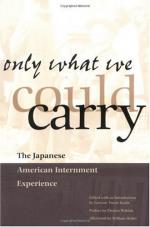|
This section contains 2,199 words (approx. 8 pages at 300 words per page) |

|
Japanese American Internment
Summary: Research paper that focuses on the deprivation of basic civil liberties on Japanese Americans during before and after the interment camps were put into effect.
In the fall of 1918, a small group of young men came together to discuss ways in order to eliminate the discrimination of their race. These Nisei, or second generation Japanese Americans, had witnessed their fathers being beaten, the windows of their homes being smashed, and their family businesses boycotted for no other reason then their ethnic background (Hosokawa 191). The Issei, or first generation Japanese immigrants, were aging and had little voice in the public, but the Nisei would not be so quiet. In 1930, determined to prevent this racism to continue, they created the Japanese American Citizens league. This organization, still in effect today, claimed a membership of approximately 20,000 people by 1942 (Unrau 4). That same year, they would all be bewildered to discover the message being sent to all Americans of Japanese ancestry. In the spring of 1942, about 70,000 Japanese Americans and 50,000 Issei, not qualified for citizenship, were forced to leave...
|
This section contains 2,199 words (approx. 8 pages at 300 words per page) |

|


